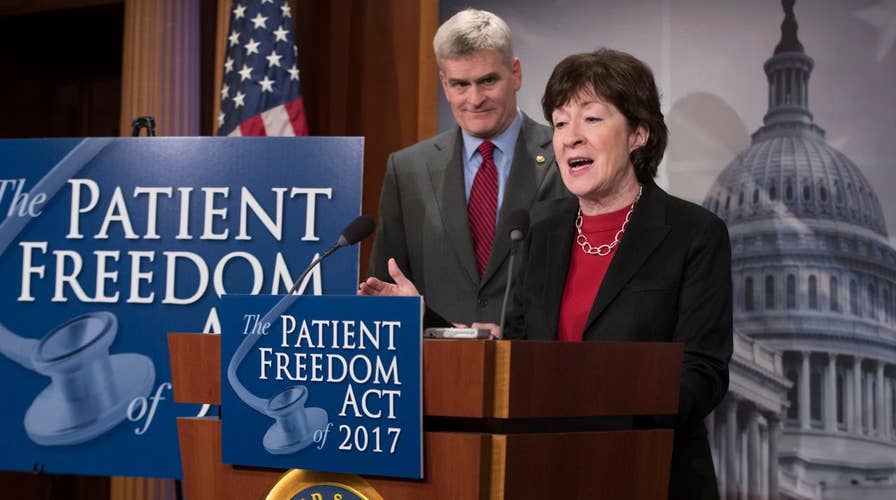Senators offer ObamaCare replacement plan
Strategy Room: Brad Bauman and Brian Morgenstern weigh in on senators Susan Collins and Bill Cassidy's ObamaCare replacement plan
Fear drives health care decisions. My role as an internist is to battle irrational fear of illness as much as possible, or sometimes to use fear of a disease to persuade you to have a preventive vaccine or colonoscopy that you shouldn’t be afraid of.
Currently, fear is exploding around ObamaCare and what to do about it. Control has largely been wrested from the states and the individual and deposited in a highly regulating federal law, which is now under attack. Fear of out-of-control health insurance premiums is currently doing battle with the fear of losing coverage altogether.
President Trump took the first symbolic step toward repeal on Friday when he issued an executive order to ease the “regulatory burdens” of ObamaCare on the states and the individual, which should at the very least lead to more exemptions and less enforcement of the law’s excess regulations.
But the yeoman’s work of repeal and replace remains. So what will work best for doctors and their patients? And what, if anything, should we really be afraid of when it comes to our health care and changing our insurance coverage?
Here is a list of what we should keep, what we should change and why.
Add a catastrophic option. One of the main problems with ObamaCare is that it mandates comprehensive coverage that includes 10 essential benefits. Preventive services and cancer screenings such as mammograms and colonoscopies are hugely important and should continue to be covered, but the entire cohort is shouldering the payment (including co-payment) in a way that is reflected in high premiums. This hardly seems fair. One way to entice more young and healthy people to sign up would be to offer them a cheaper catastrophic option that is useful for severe illness or hospitalization.
Repeal the individual mandate. Only 30 percent of ObamaCare’s customers are young people (age 18 to 34). The individual mandate is ineffective and can be replaced by market-driven solutions like Health Savings Accounts and cheaper policies that benefit from competition across state lines.
Decrease most subsidies, reduce taxes and disband the state exchanges. ObamaCare includes 22 taxes, and two-thirds of the policies available at the state exchanges are subsidized. Extensive subsidies are often necessary because the policies are overloaded with many unnecessary services determined by lawmakers rather than doctors.
Subsidies should be reserved for high-risk pools to cover those with pre-existing conditions. High-risk pools should be restored to offer comprehensive policies.
Maintain Medicaid expansion for those 18 to 65 with incomes at 133 percent of the federal poverty level, but use the efficiency model instituted successfully in Indiana and Ohio that involves a physician-guided health care team to administer care. Funding can still be mainly federal (block grants) to avoid cost sharing.
Expand physician networks. Successful health care is all about choice on both the patient and the doctor sides of the ledger. Out-of-network benefits have shrunk under ObamaCare, but they are crucial to my choosing the best test or treatment for my patient. They should be restored as an option.
Expand health savings accounts. Tax-deductible out-of-pocket payments can be used to pay for insurance premiums as well as innovative personalized solutions that are not easily covered by one-size-fits-all insurance. Choices will increase, and competition among providers will drive down prices.
Public health. Mandate coverage for true public health services such as vaccines, emergency room visits and hospitalization for severe and contagious illness.
Expand access, rather than coverage. If your insurance is portable from job to job and across state lines, and it allows you to see the doctor of your choice with far fewer regulations that restrict access to tests and treatments, your health care will be higher quality. Remember, you can theoretically have coverage, but it is useless if it denies access to an actual test or treatment. (With ObamaCare, I can send you for a partial knee replacement or a trans catheter aortic valve replacement or the latest immunotherapy, provided I can find a specialist who accepts your insurance.) Deductibles of the future can depend on the policy or the service ordered. Patients should be able to choose what they want to suit their expected needs. ObamaCare’s uniformly high deductibles lead to the frustrating reality of screening being fully covered, but a patient being unable to afford further testing or the intervention that’s required. High deductibles have kept many of my patients from obtaining follow-up imaging as well as lung, breast and thyroid biopsies for concerning nodules.
Let everyone keep their current policies. Until the smoke clears and ObamaCare is reformed, no one should have to lose their current plan. So you get to keep your doctor and your plan.
Allow young adults to remain on their parents’ policies until 26.
This is a popular feature of ObamaCare that should survive. It allows young people the opportunity to start their professional lives without instantly worrying about health insurance.

